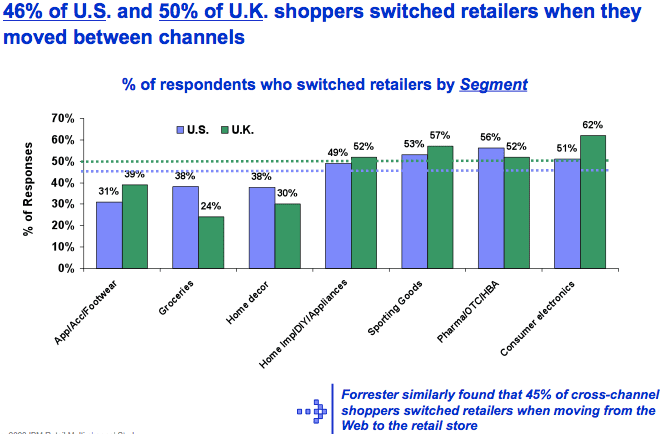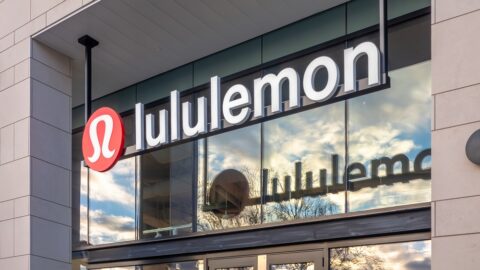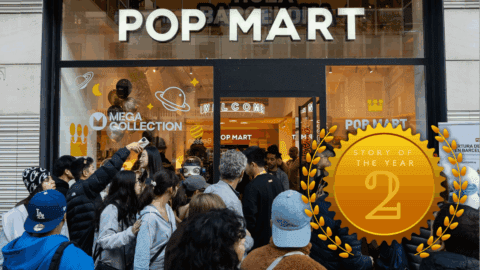Though cross channel retailing has become a priority retailers cannot ignore, implementing the cutting edge technology and tactical measures seems to leave companies at the starting gate. To address these and other business challenges, several new research studies were presented as part of a recent Retail TouchPoints webinar titled “Cross Channel Retailing for the Anytime/Anywhere Consumer.”
Fusing together the latest cross channel trends and challenges, thought leaders from IBM, RSR Research and Manhattan Associates shared insights and data on how retailers must understand the shopping patterns of the cross channel consumer.
“When we talk about cross channel retailing, we really need to start with the customer first and what the customer expectations are as they interact with retailers via any touch point: the Web site, the retail store,” said Craig Stevenson, Global Portfolio Leader, Consumer Experience Solutions, IBM Global Retail Industry. “In the future it will be mobile devices, along with call centers and digital worlds.”
Stevenson suggested mobile devices will emerge as a fourth channel, pointing out that 1 billion users globally will use their mobile phone to browse the internet by 2011. “What we’ve seen in the 90s with the internet is what’s happening with the mobile phone,” Stevenson says. “This will be the dominant channel to interact with consumers both in-store and outside the store.”
Because the mobile phone has infiltrated the retail environment, consumers are increasingly informed, empowered and demanding. Stevenson referred to “super shoppers” as more informed and knowledgeable when entering the sales cycle. Their desires and expectations of value have been increased as a result of the information at their fingertips. “Consumers are really expecting more and we have to provide more to them if we want to have a loyal customer over time,” he says.
Consumer Insight
Stevenon shared the findings from IBM’s Cross Channel Shopping Study which found that 78% of consumers are engaged in online research and in store transaction. The study, which surveyed over 4,000 consumers in the US and UK, indicates that 34% of US shoppers say the reason they move from online to in-store to shop is because they wanted to see, touch/ smell and experience items before purchasing—while 17% wanted the product immediately.The study found that the features most frequently valued were:
- 46% say the ability to check if an item is available at a local store while browsing online is a must have
- 45% say an online store locator feature is a must have
Top reasons shoppers move from store to online are related to price, convenience and assortment. 30% of US consumers said “I could buy the item for less online than in store, compared to 46% in the UK. “If you can keep a customer within a given channel so they don’t have to change the channel, that’s probably ideal,” noted Stevenson. “The way to do that is to figure out why they changed channels.”
While most retailers realize the need to better address the needs of cross channel shoppers, Paula Rosenblum, Managing Partner with RSR Research, pointed out organizational inhibitors are often keeping them from taking advantage of opportunities.
Retail Winner Insight
According to recent RSR data shared by Rosenblum, retail winners are seeing year-over-year comparable store sales outperform the market. They not only sell more “stuff;” they also think and act differently than their competitors, like working multiple channels, according to RSR Research.
The RSR Research also found there is a significant difference when you institute and implement enterprise buying along with channel forecasting. 31% of laggards do their planning and forecasting enterprise wise but they don’t actually pull the trigger on buying, whereas 64% of retail winners do enterprise wide planning, forecasting and buying, which, Rosenblum notes is one way to gain efficiency and ultimately, gain more sales. “In this economic climate, operational efficiencies have eclipsed customer considerations,” noted Rosenblum. “We need to improve operational efficiencies.”
Rosenblum said it is imperative for cross channel retailers to create a single brand identify across channels. 85% or retail winners understand the value of a consistent and clear explanation of product features and benefits, cross channel delivery and product returns. Winners are starting to move more toward customized, unique product offering based on customer segments—not necessarily one to one marketing, but segmentized offerings, which is a critical difference between winners and laggards. These efforts have found winners enjoying stunning quantifiable benefits:
- 85% reported improved customer satisfaction from ensuring product information and pricing is up to date and consistent across channel.
- 40% report a 3-5% increase in ecommerce profitability
- 29% report a 5-10% increase in overall return on inventory investment
Like Stevenson, Rosenblum emphasized the mobile phone’s role in retail. “Clearly our industry is under investing in mobile commerce,” she says. “Companies like Amazon are taking that opportunity and they will just lengthen their lead.” She also noted that smart phones are really disruptive technologies and retailers can expect customers to be walking stores like a show room if retailers don’t have some kind of mobile commerce enabled offering.
Order Lifecycle Management
To illustrate how leading retailers are benefitting from aligning their cross channel capabilities, Brian Kinsella, Senior Director at Manhattan Associates shared examples from David’s Bridal and other successful cross channel retailers.
Addressing one of retailer’s biggest cross channel challenges — inventory segmentation—Kinsella said Manhattan Associates partnered with the IBM WebSphere team to proide retailers with a complete end to end solution from the time a customer wants to research a product online, through building a shopping cart, and picking up in store. “We know those are the problems retailers are trying to understand,” Kinsella said. “So we have built the integration to offer the best in class capabilities in the WebSphere commerce application for order acquisition and cart conversion, as well as the best in class fulfillment inventory visibility and fulfillment capability of warehouse management and supplier enablement.”
Manhattan recently worked with David’s Bridal to expand their sales channels. Saddled with older systems which were not scalable or configurable, Kinsella said David’s Bridal utilized the WebSpere Commerce solution and Manhattan’s Distributed Order Management application to eliminate seven legacy order management/allocation/visibility systems. The consolidation accelerated new business processes by automating store to store transfers. Because of the nature of bridal retailing, the need for real-time automated processing of special order is critical.
“It’s not enough just to be able to pull up the inventory in one place,” said Kinsella. “You have to understand that at any given time, at each stage, or lifecycle of the inventory, how much has been allocated and how much is net available.”













